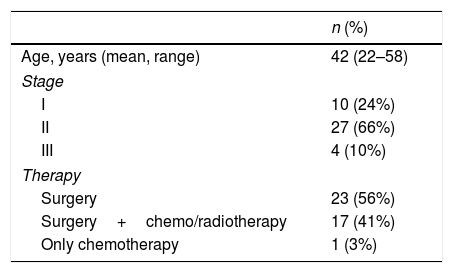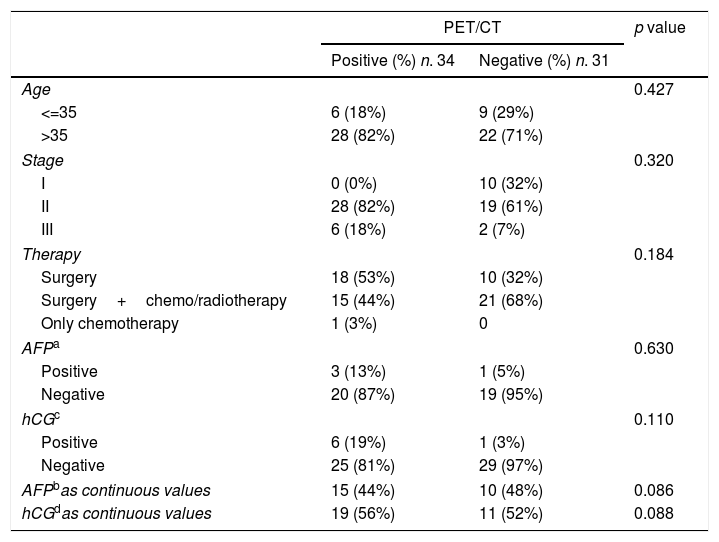The aim of our study was to analyze the potential relationship between tumor markers and 18F-fluorodoxyglucose positron emission tomography/computed tomography (18F-FDG PET/CT) results in patients affected by seminoma.
Material and methods65 18F-FDG PET/CT scans of 41 patients with diagnosis of seminoma were analyzed and compared to alpha-fetoprotein (AFP) and human chorionic gonadotropin (hCG). PET/CT studies were analyzed qualitatively and measuring the maximum and mean standardized uptake value body weight max (SUVbwmax, SUVbwmean), maximum SUV lean body mass (SUVlbm), maximum SUV body surface area (SUVbsa), metabolic tumor volume (MTV) and total lesion glycolysis (TLG) of hypermetabolic lesions. All values were compared with serum markers.
Results31 PET/CT studies were true negative, 28 true positive, 6 false positive and 0 false negative with sensitivity of 100%, specificity of 84%, negative predictive value of 100%, positive predictive value of 82% and accuracy of 91%. No correlation between PET results and tumor marker levels was found and also between AFP and PET/CT semiquantitive parameters. All semiquantitative PET parameters were significantly related to hCG level.
Conclusions18F-FDG PET/CT has good accuracy in evaluating patients with relapsed seminoma. HCG levels were significantly correlated with metabolic PET/CT parameters.
El objetivo de nuestro estudio fue analizar la posible relación entre los marcadores tumorales y los resultados de la tomografía por emisión de positrones con 18F-fluorodoxiglucosa/tomografia computarizada (18F-FDG PET/CT) en pacientes afectados por seminoma.
Material y métodose analizaron 65 exploraciones PET/TC 18F-FDG de 41 pacientes con diagnóstico de seminoma y se compararon con alfafetoproteína (AFP) y gonadotropina coriónica humana (hCG). Los estudios PET/CT se analizaron cualitativamente y midieron el valor máximo y medio de la captacion estandarizada de peso corporal maximo (SUVbwmax, SUVbwmean), masa corporal magra SUV maxima (SUVlbm), área de superficie corporal máxima de SUV (SUVbsa), volumen tumoral metabólico (MTV) y glucólisis de lesión total (TLG) de lesiones hipermetabolicas. Todos los valores se compararon con marcadores sericos.
Resultados31 estudios PET/CT fueron verdaderos negativos, 28 verdaderos positivos, 6 falsos positivos y 0 falsos negativos con sensibilidad del 100%, especificidad del 84%, valor predictivo negativo del 100%, valor predictivo positivo del 82% y precision de 91%. No se encontro correlación entre los resultados de PET y los niveles de marcadores tumorales y tampoco entre los parámetros semicuantitativos de AFP y PET/CT. Todos los parámetros semicuantitativos de PET se relacionaron significativamente con el nivel de hCG.
Conclusiones18F-FDG PET/CT tiene buena precisión en la evaluación de pacientes con seminoma recidivante. Los niveles de HCG se correlacionaron significativamente con los parametros metabolicos de PET/CT.
Artículo

Revista Española de Medicina Nuclear e Imagen Molecular (English Edition)
Comprando el artículo el PDF del mismo podrá ser descargado
Precio 19,34 €
Comprar ahora











